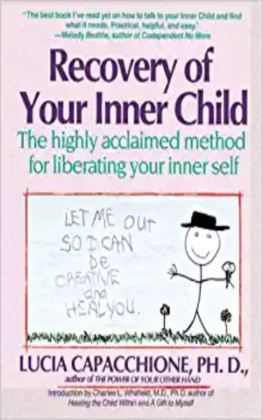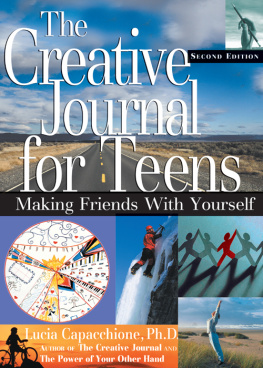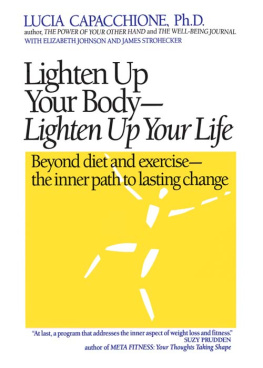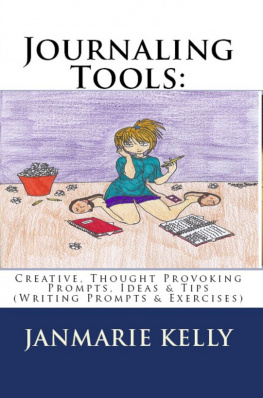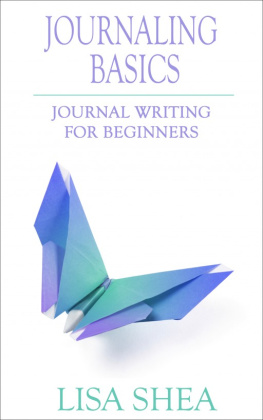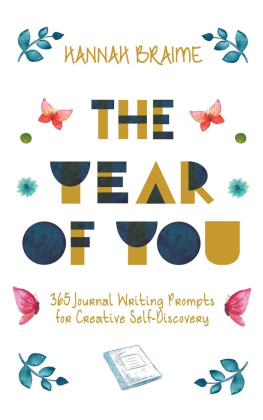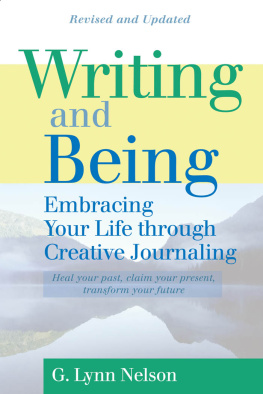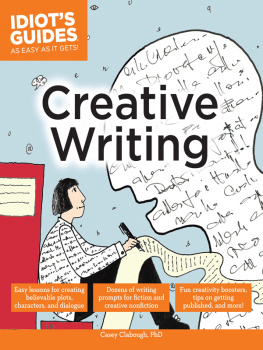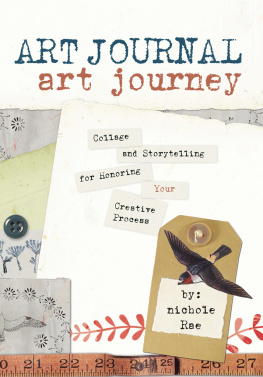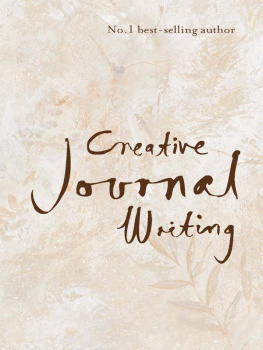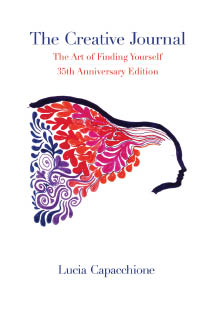
Other Books by Lucia Capacchione
The Power of Your Other Hand
Recovery of Your Inner Child
Visioning: Ten Steps to Designing the Life of Your Dreams
The Art of Emotional Healing
The Creative Journal for Children
The Creative Journal for Teens
The Creative Journal for Parents
The Talent Workbook ebook at luciac.com
The Inner Child Play Book ebook at luciac.com
CD Programs available at luciac.com
The Wisdom of Your Other Hand CD series ( )
The Picture of Health (Drawing and writing for health and healing)
To contact Lucia Capacchione visit:
www.luciac.com
www.visioningcoach.org
www.visioningcoach.blogspot.com
For information about Creative Journal Expressive Arts training for
certification to teach, coach, or counsel with The Creative Journal Method,
email us: cjea@charter.net or visit www.luciac.com > Training section.
The Creative Journal Method is not a substitute for therapy. If you need psychological or medical help, find a professional therapist, counselor, or medical professional who can guide and help you.
The Creative Journal
The Art of Finding Yourself
35th Anniversary Edition
Lucia Capacchione, PhD, ATR
Swallow Press
Ohio University Press
Athens
Swallow Press
An imprint of Ohio University Press, Athens, Ohio 45701
ohioswallow.com
2015 by Ohio University Press
All rights reserved
To obtain permission to quote, reprint, or otherwise reproduce or distribute material from Swallow Press / Ohio University Press publications, please contact our rights and permissions department at ( ) - 1154 or ( ) - 4536 (fax).
Printed in the United States of America
Swallow Press / Ohio University Press books are printed on acid-free paper
Library of Congress Cataloging-in-Publication Data
Capacchione, Lucia, author.
The creative journal : the art of finding yourself / Lucia Capacchione. th anniversary edition.
pages cm
Includes bibliographical references.
ISBN 978-0-8040-1163-1 (hc : alk. paper) ISBN 978-0-8040-1164-8 (pb : alk. paper) ISBN 978-0-8040-4067-9 (pdf)
Self-perceptionProblems, exercises, etc. Creative abilityProblems, exercises, etc. I. Title.
BF 697.C27 2015
158.1 dc
2015026395
Cover art: Lucia Capacchione
Acknowledgments
Illustrations, both drawn and written, are from the journals of students in my Creative Journal classes:
Felice Bachrach Star Jenkins
Robin Baltic Joyce King
Regina Barton Jane Murphy
Victoria Becker Mary Jane Maier
Elaine Bourne Celia Pearce
Gary Brown Carole Petracca
Lucia Capacchione Ruth Randle
Albert Cirimele Carroll Shupe
Jane Kelly Corns Suzanne Stokes
Bill Eidelman Jennifer Svendsen
Lucille Isenberg Marge Windish
My deepest thanks to you all and to all the students, past and future, who make the class such a joy for me.
My gratitude also to the Santa Monica YWCA and its director, Beverly Sanborn, who believed in the Creative Journal course and helped it to be born. And thanks to Los Angeles City College Community Services for sponsoring my early workshops.
Dedicated to Anas Nin,
who inspired me to keep
a journal in the first place
Introduction
When I wrote The Creative Journal in 1977 , the world was a very different place. The manuscript was written on an IBM Selectric typewriter. Pocket- sized cell phones, personal computers, the Internet, and social networking were unheard of. It was before the school shootings at Columbine, / , Hurricane Katrina, and the Gulf of Mexico oil spill. On the heels of the s Civil Rights Movement, the Womens Movement was happening and consciousness-raising groups had been launched. Self-help books, therapy, and twelve-step programs based on personal responsibility and the principle that change starts within were gaining popularity. New forms of psychotherapy using the arts were being pioneered. Social experiments and psychological exploration of that era would alter forever the way we see ourselves and our relationships. In this atmosphere of innovation, I began developing the body of work I now call Creative Journal Expressive Arts.
My early art therapy clients and Creative Journal students taught me more than I could have imagined about transformation through drawing and writing in a journal. My gratitude to them is deep and wide, especially to those who contributed to this book. Their images and words speak to us of universal human themes and experiences. In pouring out their feelings, struggles, and breakthroughs, these dedicated journal keepers (none of them professional artists or writers at the time) laid bare all that makes us human and opens us to the divine within ourselves. The result was a collection of drawings and writings that still speak to our hearts today. We can thank these Creative Journal keepers for the juiciness and soulfulness of this book.
It is clear that there has never been a greater need for The Creative Journal. It is no accident that the book has stayed in print all these years. Hailed as a pioneering work and a classic in the art therapy field, it has been a required text in art therapy programs and college courses, a guide in writing, memoir, art, journal, and creativity workshops throughout the world. Steadily increasing mail from readers tells me The Creative Journal is still inspiring and transforming countless lives.
Since the publication of this book, research has been done on the healing power of writing about trauma, illness, and life crises. This research, pioneered by psychologist Dr. James Pennebaker, author of Opening Up and Writing to Heal, has been replicated by others with similar results. In control group studies in the s, Pennebaker showed that writing and talking about trauma had a positive effect on physical health. Blood tests before and after showed a strengthening of the immune system and fewer doctor visits compared to control groups who wrote about any topic of their choice. This research echoes my Creative Journal work with cancer and AIDS/HIV-positive groups. Sharing journal entries in a Creative Journal group or with a therapist has been shown to be a powerfully healing process. When I met with Dr. Pennebaker after the publication of his research, he encouraged me to do my own studies on the impact of drawing in addition to writing. (My research appears in the Applications section.) Dr. Pennebaker also endorsed my second book, The Power of Your Other Hand.
In recent years there has been a flood of research on neurobiology and neuro- psychology as it relates to therapy. The scientific discovery of the neuroplasticity of the brain has confirmed the clinical observations of us pioneers of methods for changing the brain. The writings of authors such as Daniel Siegel, MD, psychologist Alan Schore, and psychiatrist Norman Doidge, MD, support what art therapists, play therapists, and expressive arts therapists have known for years: art heals. In her book Neurobiologically Informed Trauma Treatment with Children and Adolescents, art therapist Nancy Chapman presents case studies that clearly illustrate this fact. There are scores of other books, including my own, that illustrate the healing power of the arts.
New Questions
As the world has changed, new questions and issues have been raised by readers, students, and clients using The Creative Journal.
The Creative Journal and Technology: The Medium Is the Message
Rapidly advancing technology has altered the way we write, design, and create visual art. I am often asked if Creative Journaling can be done on a computer or tablet. The answer is, No. In order to fully benefit from The Creative Journal it is essential to use high-touch media such as paper, felt pens, markers, crayons, oil pastels, and collage. In this case, Marshall McLuhans dictum, The medium is the message, has never been more true. Simple, tactile art materials used in The Creative Journal open sensory awareness, emotional expression, and creative exploration. Childlike spontaneity, discovery, insight, and inner wisdom unfold as a result of engaging with art materials that are highly sensorial and conducive to releasing feelings. High-tech devices have their place, but they limit our physical movements. They cannot provide the range of motion, the sensual and primitive play, or the emotional release found in The Creative Journal art and writing activities.
Next page

